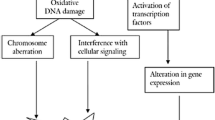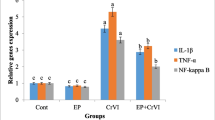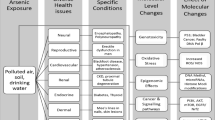Abstract
Cymbopogon citratus, commonly known as lemongrass - a herb in Asian cuisine, is well known for its medicinal properties since ancient period and have been reported in ancient Indian Ayurvedic Medicine for relieving cough and nasal congestion. Since the early 1980s, an alarming problem of groundwater arsenic (As) contamination has devastated eastern Indian regions. Arsenic is a known human carcinogen and an environmental pollutant known to cause adverse health effects such as liver injury, neurotoxicity, increase the risk of cancers of skin, lung, bladder and liver. DNA damage and genetic instability induced by the inorganic arsenicals present in water are thought to be prerequisites for the initiation of carcinogenesis. Many natural herbs, which are consumed through our daily diet, possess excellent cancer chemopreventive properties. The present study was conducted to examine the anticlastogenic action of lemongrass extract against the As-induced chromosomal aberrations. Our results demonstrate that lemongrass extract particularly Citral (60 mg/kg/b.w) is effective in counteracting the clastogenicity, of the most potent form of As, sodium arsenite in mice. These results suggest that the use of lemongrass in diet may give an effective protection against the health crisis generated by As.

Similar content being viewed by others
References
Aposhian HV. Biochemical toxicology of arsenic. In: Hodgson E, Bend JR, Philpot RM, editors. Reviews in biochemical toxicology. New York: Elesvier; 1989. p. 265–99.
Behboud J, Amirreza E, Babak MA, Zarifeh H. Antibacterial activities of lemon grass methanol extract and essence on pathogenic bacteria. J Agric Environ Sci. 2012;12:1042–6.
Chakraborti D, Rahman MM, Paul K, Sengupta MK, Chowdhury UK, Lodh D, et al. Arsenic calamity in India and Bangladesh sub-continent-whom to blame? Talanta. 2002;58:3–22.
Chowdhury UK, Biswas BK, Chowdhury TR, Samanta G, Mandal BK, Basu GC, et al. Groundwater arsenic contamination in Bangladesh and West Bengal, India. Environ Health Perspect. 2000;108:393–7.
Das AK, Bag S, Sahu R, Dua TK, Sinha MK, et al. Protective effect of Corchorus olitorius leaves on sodium arsenite-induced toxicity in experimental rats. Food Chem Toxicol. 2010;48:326–35.
Dhir H, Agarwal K, Sharma A, Talukder G. Modifying role of Phyllanthus emblica and ascorbic acid against nickel clastogenicity in mice. Cancer Lett. 1991;59:9–18.
Dudai N, Weinstein Y, Krup M, Rabinski T, Ofir R. Citral is a new inducer of caspase-3 in tumor cell lines. Planta Med. 2005;71:484–8.
Heiba HI, Rizk AM. Constituents of Cymbopogon species. Qatar Univ Sci Bull. 1986;6:53–75.
Hayatsu J, Arimoto S, Negishi T. Dietary inhibitors of mutagenesis and carcinogenesis. Mutat Res. 1988;202:429–46.
IARC (International Agency for Research on Cancer). IARC monograph on the Evaluation of Carcinogenic risk to humans-overall evaluation of carcinogenicity. Int Agency Res Cancer Lyon. 1987; (supp. 7):100.
Jacobson-Kram D, Montalbano D. The reproductive effects assessment group’s report of mutagenicity of inorganic arsenic. Environ Mutagen. 1985;7:707–804.
Kochar TS, Howard W, Hoffman S, Brammer-Carleton L. Effect of trivalent and pentavalent arsenic in causing chromosome alterations in cultured Chinese hamster ovary (CHO) cells. Toxicol Lett. 1996;84:37–42.
Koul VK, Gandotra BM, Suman K, Ghosh S, Tikoo CL, Gupta AK. Steam distillation of lemongrass (cymbopogan spp). Indian J Chem Technol. 2004;11:135–9.
Nikos GT, Costas DE. Antifungal activity of lemongrass (Cympopogon Citratus L.) essential oil against key postharvest pathogens. Innov Food Sci Emerg Technol. 2007;8:253–5.
Preston RJ, Dean BJ, Galloway S, Holden H, McFee AF, Shelby MD. Mammalian in vivo cytogenetics assay: analysis of chromosome aberration in bone marrow cells. Mutat Res. 1987;189:157.
Roy S, Roy M, Pandey PK, Tiwari SP. Effects of tissue trace minerals status and histophathological changes in chronic arsenicosis in goats. Vet World. 2009;2:8–9.
Shadab O, Hanif M, Chaudhary FM. Antifungal activity by lemongrass essential oils. Pak J Sci Int Res. 1992;35:246–9.
Sharma A, Sharma MK, Kumar M. Modulatory role of Emblica officinalis fruit extract against arsenic induced oxidative stress in Swiss albino mice. Chem Biol Interact. 2009;180:20–30.
Sinha D, Roy M, Siddiqi M, Bhattacharya RK. Arsenic-induced micronuclei formation in mammalian cells and its counteraction by tea. J Environ Pathol Toxicol Oncol. 2005;24:45–56.
Sokal RR, Rohlf F. J. biometry. 3rd ed. San Franciso: Freeman; 1981.
Varshney SC. Essential Oil Industry in India. 1st ed. New Delhi: Essential Oil Association of India; 1992.
Vutukuru SS, Prabhath NA, Raghavender M, Yerramilli A. Effect of arsenic and chromium on the serum amino-transferases activity in Indian major carp, Labeo rohita. Int J Environ Res Public Health. 2007;4:224–7.
Wang XD, Krinsky NI, Tang GW, Russell RM. Arch Biochem Biophys. 1992;293:298–304.
WHO (World Health Organization) Guidelines for drinking water quality Vol. 1: Recommendations. 2d eds., Geneva, 1993.
Yamanaka K, Hoshino M, Okamoto M, Sawamura R, Hasegawa A, Okada S. Biochem Res Commun. 1990;168:58–64.
Acknowledgments
Puspal De acknowledges Institute of Genetic Engineering for funding and affiliation. We are also thankful to other laboratory members and other associated persons of IGE for their enthusiastic participation.
Competing Interests Statement
The authors declare that they have no competing interests.
Contributorship Statement
Dr. Madhumita J Mukhopadhyay helped in the preparation of manuscript with the discussion and data summary. Puspal De performed all the experiments, laboratory work and analysis. Dr. Amit Chakravarty provided the financial support. All authors read and approved the final manuscript.
Data Sharing Statement
We cannot share any unpublished data with other laboratory or person.
Author information
Authors and Affiliations
Corresponding author
Rights and permissions
About this article
Cite this article
De, P., Mukhopadhyay, M.J. & Chakravarty, A. Lemongrass - an anticlastogenic agent against arsenic. Nucleus 58, 125–129 (2015). https://doi.org/10.1007/s13237-015-0141-4
Received:
Published:
Issue Date:
DOI: https://doi.org/10.1007/s13237-015-0141-4




